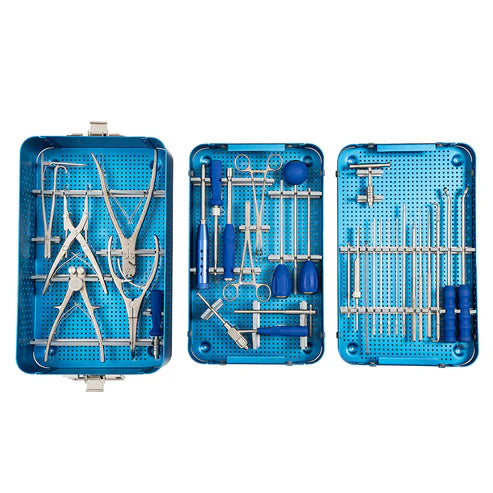Posterior cervical fixation is a vital procedure in spine surgery that seeks to stabilize the cervical spine and relieve pain or neurological deficits resulting from various spinal disorders. Advanced techniques and specialized tools are relied upon by surgeons so as to attain successful outcomes. The blog post focuses on the posterior cervical fixation sets, highlighting their components, applications, and why Peak Surgicals is your go-to source for these vital surgical instruments.
Understanding Posterior Cervical Fixation
Posterior cervical fixation involves inserting screws, rods, among other implants to stabilize the back part (posterior) of the neck vertebrae. It’s a commonly used technique in treating conditions such as cervical spondylotic myelopathy, traumatic fractures, tumors and degenerative disc disease. This provides necessary stability for proper healing while relieving pain by immobilizing affected vertebrae.
Key Components of Posterior Cervical Fixation Sets
Pedicle Screws
Pedicle screws are fundamental in posterior cervical fixation process. These screws are inserted into pedicles of the vertebrae in order to provide a firm base. Their build ensures that they hold steady hence allowing connection of rods plus plates which help stabilize the spinal column.
Rods and Plates
Rods together with plates are used in joining pedicle screws forming strong construct that keeps all the vertebrates aligning them together. To suit diverse anatomical needs and surgeon’s preferences this can be achieved by having different lengths and varied configuration for these components.
Crosslinks
Crosslinks enhance stability within rod constructs when added between rods themselves; spreading mechanical stresses more evenly thereby minimizing hardware failure probabilities.
Reduction Instruments
Reduction instruments help to straighten out deformed vertebrae during operations by holding them properly aligned before fixing occurs.
Bone Grafting Materials
Bone grafts are used with posterior cervical fixation to ensure fusion of the vertebrae together. These substances are made in such a way that enhances new bone development and thus guaranteeing lasting stability.
Advanced Techniques in Posterior Cervical Fixation
Minimally Invasive Surgery (MIS)
Posterior cervical fixation has been tremendously improved by minimally invasive techniques. MIS approaches entail reduced size incisions, less muscle dissection as well as lesser tissue injury. This leads to decreased recovery times, postoperative pain and infection rates. The specialized instruments for MIS that come along with posterior cervical fixation sets help surgeons do these procedures with accuracy.
Navigation and Imaging Technologies
The accuracy of posterior cervical fixation has been greatly enhanced by advanced imaging and navigation technologies. Real-time guidance through intraoperative CT scans, fluoroscopy and navigation systems aid in precise positioning of screws and implants by surgical team’s hands. This results into lessened occurrence of complications coupled with better patient outcomes.
Expandable Implants
Expandable implants are new innovations in the field of posterior cervical fixation. Thus, these implants can be adjusted during surgery so as to achieve optimum alignment as well as stability desired by the surgeon himself or herself at that particular moment only. Their versatility makes them particularly useful in complex cases where standard implants may not suffice.
Applications of Posterior Cervical Fixation Sets
Trauma Surgery
Conditions involving traumatic injuries to the cervical spine like fractures or dislocations are usually treated using posterior cervical fixation technique. It is possible for proper healing to take place due to stability given by this set hence preventing further damage on spinal cord itself.
Degenerative Conditions of the Spine
Severe pain and neurological deficits may result from conditions such as cervical spondylotic myelopathy and degenerative disc disease. Posterior cervical fixation offers essential stability to alleviate symptoms and improve quality of life.
Tumor Excision
For spinal tumors, after tumor resection, posterior cervical fixation is commonly used to stabilize the spine. It prevents spinal instability and ensures the structure integrity of the spine.
Why Peak Surgicals?
The key criterion in selecting posterior cervical fixation sets is their quality and reliability. They are reputed for making high-quality, precision-made tools that meet the medical requirements of physicians. Here is why you should select Peak Surgicals:
Quality Assurance
Peak Surgicals specializes in delivering top-quality surgical devices. Their posterior cervical fixation sets are manufactured from advanced materials using cutting-edge technology thereby guaranteeing durability as well as functionality.
Innovative Solutions
Modern surgical practices require innovative designs for some instruments being used by surgeons. So finely crafted are their posterior cervical fixation sets that they have a number of tools that enable them to perform procedures with precision, accuracy, and ease.
Supported Options
A wide array of surgical tools offered by Peak Surgicals caters for different needs among healthcare providers who specialize in various fields. In this regard, posterior cervical fixation has been divided into different categories to suit your preferences.
Superb Assistance Team
Customers’ satisfaction remains one of the main aspects at Peak Surgicals’. Their dedicated support team can always help you out whenever you need them reaching their customer experience goals with seamless purchasing process.
Posterior Cervical Fixation (PCF) Sets: Key for Successful Outcomes In Cervical Spinal Surgeries
Advanced constituents and inventive design ensure precision during intricate operations by surgeons when using PCFs. By choosing Peak Surgicals’ products for your posterior cervical fixing requirements, you get an assurance on quality, consistency and novelty associated with it all. Hence, for all your medical instruments, trust Peak Surgicals and discover what a difference quality makes to your practice.
